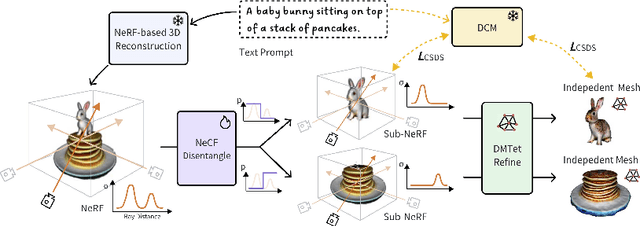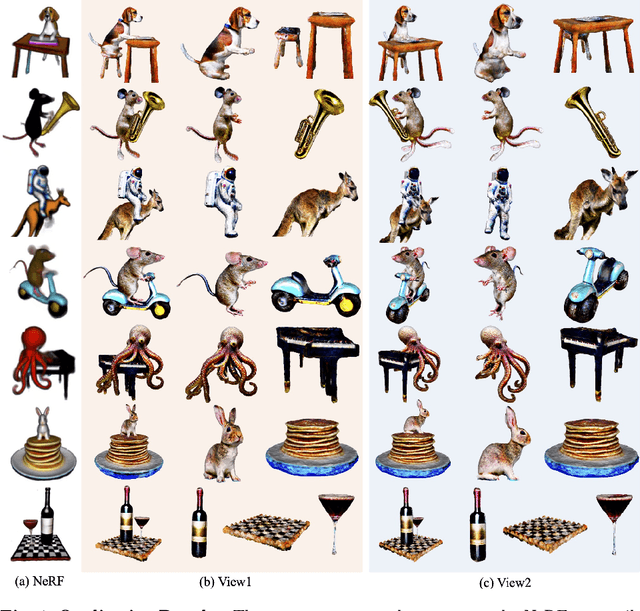Guanying Chen
LHM: Large Animatable Human Reconstruction Model from a Single Image in Seconds
Mar 13, 2025Abstract:Animatable 3D human reconstruction from a single image is a challenging problem due to the ambiguity in decoupling geometry, appearance, and deformation. Recent advances in 3D human reconstruction mainly focus on static human modeling, and the reliance of using synthetic 3D scans for training limits their generalization ability. Conversely, optimization-based video methods achieve higher fidelity but demand controlled capture conditions and computationally intensive refinement processes. Motivated by the emergence of large reconstruction models for efficient static reconstruction, we propose LHM (Large Animatable Human Reconstruction Model) to infer high-fidelity avatars represented as 3D Gaussian splatting in a feed-forward pass. Our model leverages a multimodal transformer architecture to effectively encode the human body positional features and image features with attention mechanism, enabling detailed preservation of clothing geometry and texture. To further boost the face identity preservation and fine detail recovery, we propose a head feature pyramid encoding scheme to aggregate multi-scale features of the head regions. Extensive experiments demonstrate that our LHM generates plausible animatable human in seconds without post-processing for face and hands, outperforming existing methods in both reconstruction accuracy and generalization ability.
MaterialMVP: Illumination-Invariant Material Generation via Multi-view PBR Diffusion
Mar 13, 2025Abstract:Physically-based rendering (PBR) has become a cornerstone in modern computer graphics, enabling realistic material representation and lighting interactions in 3D scenes. In this paper, we present MaterialMVP, a novel end-to-end model for generating PBR textures from 3D meshes and image prompts, addressing key challenges in multi-view material synthesis. Our approach leverages Reference Attention to extract and encode informative latent from the input reference images, enabling intuitive and controllable texture generation. We also introduce a Consistency-Regularized Training strategy to enforce stability across varying viewpoints and illumination conditions, ensuring illumination-invariant and geometrically consistent results. Additionally, we propose Dual-Channel Material Generation, which separately optimizes albedo and metallic-roughness (MR) textures while maintaining precise spatial alignment with the input images through Multi-Channel Aligned Attention. Learnable material embeddings are further integrated to capture the distinct properties of albedo and MR. Experimental results demonstrate that our model generates PBR textures with realistic behavior across diverse lighting scenarios, outperforming existing methods in both consistency and quality for scalable 3D asset creation.
AniGS: Animatable Gaussian Avatar from a Single Image with Inconsistent Gaussian Reconstruction
Dec 03, 2024



Abstract:Generating animatable human avatars from a single image is essential for various digital human modeling applications. Existing 3D reconstruction methods often struggle to capture fine details in animatable models, while generative approaches for controllable animation, though avoiding explicit 3D modeling, suffer from viewpoint inconsistencies in extreme poses and computational inefficiencies. In this paper, we address these challenges by leveraging the power of generative models to produce detailed multi-view canonical pose images, which help resolve ambiguities in animatable human reconstruction. We then propose a robust method for 3D reconstruction of inconsistent images, enabling real-time rendering during inference. Specifically, we adapt a transformer-based video generation model to generate multi-view canonical pose images and normal maps, pretraining on a large-scale video dataset to improve generalization. To handle view inconsistencies, we recast the reconstruction problem as a 4D task and introduce an efficient 3D modeling approach using 4D Gaussian Splatting. Experiments demonstrate that our method achieves photorealistic, real-time animation of 3D human avatars from in-the-wild images, showcasing its effectiveness and generalization capability.
Photometric Inverse Rendering: Shading Cues Modeling and Surface Reflectance Regularization
Aug 13, 2024



Abstract:This paper addresses the problem of inverse rendering from photometric images. Existing approaches for this problem suffer from the effects of self-shadows, inter-reflections, and lack of constraints on the surface reflectance, leading to inaccurate decomposition of reflectance and illumination due to the ill-posed nature of inverse rendering. In this work, we propose a new method for neural inverse rendering. Our method jointly optimizes the light source position to account for the self-shadows in images, and computes indirect illumination using a differentiable rendering layer and an importance sampling strategy. To enhance surface reflectance decomposition, we introduce a new regularization by distilling DINO features to foster accurate and consistent material decomposition. Extensive experiments on synthetic and real datasets demonstrate that our method outperforms the state-of-the-art methods in reflectance decomposition.
DreamDissector: Learning Disentangled Text-to-3D Generation from 2D Diffusion Priors
Jul 23, 2024



Abstract:Text-to-3D generation has recently seen significant progress. To enhance its practicality in real-world applications, it is crucial to generate multiple independent objects with interactions, similar to layer-compositing in 2D image editing. However, existing text-to-3D methods struggle with this task, as they are designed to generate either non-independent objects or independent objects lacking spatially plausible interactions. Addressing this, we propose DreamDissector, a text-to-3D method capable of generating multiple independent objects with interactions. DreamDissector accepts a multi-object text-to-3D NeRF as input and produces independent textured meshes. To achieve this, we introduce the Neural Category Field (NeCF) for disentangling the input NeRF. Additionally, we present the Category Score Distillation Sampling (CSDS), facilitated by a Deep Concept Mining (DCM) module, to tackle the concept gap issue in diffusion models. By leveraging NeCF and CSDS, we can effectively derive sub-NeRFs from the original scene. Further refinement enhances geometry and texture. Our experimental results validate the effectiveness of DreamDissector, providing users with novel means to control 3D synthesis at the object level and potentially opening avenues for various creative applications in the future.
SphereHead: Stable 3D Full-head Synthesis with Spherical Tri-plane Representation
Apr 08, 2024Abstract:While recent advances in 3D-aware Generative Adversarial Networks (GANs) have aided the development of near-frontal view human face synthesis, the challenge of comprehensively synthesizing a full 3D head viewable from all angles still persists. Although PanoHead proves the possibilities of using a large-scale dataset with images of both frontal and back views for full-head synthesis, it often causes artifacts for back views. Based on our in-depth analysis, we found the reasons are mainly twofold. First, from network architecture perspective, we found each plane in the utilized tri-plane/tri-grid representation space tends to confuse the features from both sides, causing "mirroring" artifacts (e.g., the glasses appear in the back). Second, from data supervision aspect, we found that existing discriminator training in 3D GANs mainly focuses on the quality of the rendered image itself, and does not care much about its plausibility with the perspective from which it was rendered. This makes it possible to generate "face" in non-frontal views, due to its easiness to fool the discriminator. In response, we propose SphereHead, a novel tri-plane representation in the spherical coordinate system that fits the human head's geometric characteristics and efficiently mitigates many of the generated artifacts. We further introduce a view-image consistency loss for the discriminator to emphasize the correspondence of the camera parameters and the images. The combination of these efforts results in visually superior outcomes with significantly fewer artifacts. Our code and dataset are publicly available at https://lhyfst.github.io/spherehead.
Aerial Lifting: Neural Urban Semantic and Building Instance Lifting from Aerial Imagery
Mar 18, 2024Abstract:We present a neural radiance field method for urban-scale semantic and building-level instance segmentation from aerial images by lifting noisy 2D labels to 3D. This is a challenging problem due to two primary reasons. Firstly, objects in urban aerial images exhibit substantial variations in size, including buildings, cars, and roads, which pose a significant challenge for accurate 2D segmentation. Secondly, the 2D labels generated by existing segmentation methods suffer from the multi-view inconsistency problem, especially in the case of aerial images, where each image captures only a small portion of the entire scene. To overcome these limitations, we first introduce a scale-adaptive semantic label fusion strategy that enhances the segmentation of objects of varying sizes by combining labels predicted from different altitudes, harnessing the novel-view synthesis capabilities of NeRF. We then introduce a novel cross-view instance label grouping strategy based on the 3D scene representation to mitigate the multi-view inconsistency problem in the 2D instance labels. Furthermore, we exploit multi-view reconstructed depth priors to improve the geometric quality of the reconstructed radiance field, resulting in enhanced segmentation results. Experiments on multiple real-world urban-scale datasets demonstrate that our approach outperforms existing methods, highlighting its effectiveness.
OMG: Occlusion-friendly Personalized Multi-concept Generation in Diffusion Models
Mar 16, 2024Abstract:Personalization is an important topic in text-to-image generation, especially the challenging multi-concept personalization. Current multi-concept methods are struggling with identity preservation, occlusion, and the harmony between foreground and background. In this work, we propose OMG, an occlusion-friendly personalized generation framework designed to seamlessly integrate multiple concepts within a single image. We propose a novel two-stage sampling solution. The first stage takes charge of layout generation and visual comprehension information collection for handling occlusions. The second one utilizes the acquired visual comprehension information and the designed noise blending to integrate multiple concepts while considering occlusions. We also observe that the initiation denoising timestep for noise blending is the key to identity preservation and layout. Moreover, our method can be combined with various single-concept models, such as LoRA and InstantID without additional tuning. Especially, LoRA models on civitai.com can be exploited directly. Extensive experiments demonstrate that OMG exhibits superior performance in multi-concept personalization.
MOC-RVQ: Multilevel Codebook-assisted Digital Generative Semantic Communication
Jan 02, 2024Abstract:Vector quantization-based image semantic communication systems have successfully boosted transmission efficiency, but face a challenge with conflicting requirements between codebook design and digital constellation modulation. Traditional codebooks need a wide index range, while modulation favors few discrete states. To address this, we propose a multilevel generative semantic communication system with a two-stage training framework. In the first stage, we train a high-quality codebook, using a multi-head octonary codebook (MOC) to compress the index range. We also integrate a residual vector quantization (RVQ) mechanism for effective multilevel communication. In the second stage, a noise reduction block (NRB) based on Swin Transformer is introduced, coupled with the multilevel codebook from the first stage, serving as a high-quality semantic knowledge base (SKB) for generative feature restoration. Experimental results highlight MOC-RVQ's superior performance over methods like BPG or JPEG, even without channel error correction coding.
RichDreamer: A Generalizable Normal-Depth Diffusion Model for Detail Richness in Text-to-3D
Nov 28, 2023Abstract:Lifting 2D diffusion for 3D generation is a challenging problem due to the lack of geometric prior and the complex entanglement of materials and lighting in natural images. Existing methods have shown promise by first creating the geometry through score-distillation sampling (SDS) applied to rendered surface normals, followed by appearance modeling. However, relying on a 2D RGB diffusion model to optimize surface normals is suboptimal due to the distribution discrepancy between natural images and normals maps, leading to instability in optimization. In this paper, recognizing that the normal and depth information effectively describe scene geometry and be automatically estimated from images, we propose to learn a generalizable Normal-Depth diffusion model for 3D generation. We achieve this by training on the large-scale LAION dataset together with the generalizable image-to-depth and normal prior models. In an attempt to alleviate the mixed illumination effects in the generated materials, we introduce an albedo diffusion model to impose data-driven constraints on the albedo component. Our experiments show that when integrated into existing text-to-3D pipelines, our models significantly enhance the detail richness, achieving state-of-the-art results. Our project page is https://lingtengqiu.github.io/RichDreamer/.
 Add to Chrome
Add to Chrome Add to Firefox
Add to Firefox Add to Edge
Add to Edge